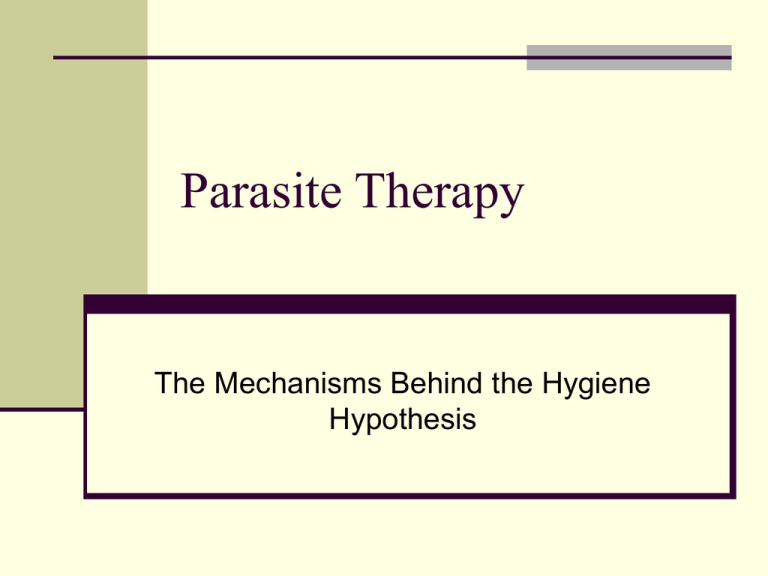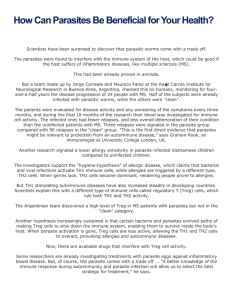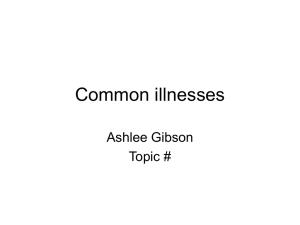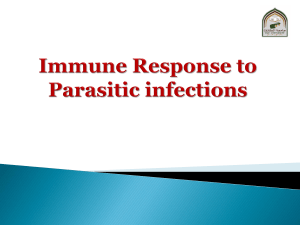Parasite Therapy The Mechanisms Behind the Hygiene Hypothesis
advertisement

Parasite Therapy The Mechanisms Behind the Hygiene Hypothesis Hygiene Hypothesis The hygiene hypothesis is that in an environment where the frequency of helminthes infection is high the rate of allergy will be low. Basically, the reaction the immune system has to parasitism acts as a regulatory mechanism for later allergic type events. The inverse correlation between type 1 diabetes (yellow) and low mortality neglected diseases (red) Mechanisms of Immunity and Allergies This regulation involves a chain of cellular events starting with the activation of dendritic cells by the presence of antigens and ends in the production of helper T cells to protect against future attacks. Autoimmune disorders and allergies result from a hypersensitivity of T cells to antigens. How Parasites Influence This Mechanism The immune system response of the host to parasite infection is first the binding of IgG or IgE which up regulate the activity of other immune factors like the dendritic cells. The dendritic cells through messenger molecules like IL-10 initiate production of TH2 cells and Treg cells which are the necessary products to avoiding hypersensitivity to allergens. The Best Parasites For Regulation Early research found that, in general, parasites will lower the prevalence of allergies. Newer studies and meta-analysis have shown that certain parasites are better than others at providing regulatory factors. Conclusion Further research is required though before we can treat patients with helminthes to cure allergies. Another interesting finding Recent research has shown that parasite richness is related to genetic disposition to autoimmune disease and some links have been made between the phylogeny of parasites and human immune factors. References Fumagalli, M., Pozzoli, U., Cagliani, R., Comi, G.P., Riva, S., Clerici, M., Bresolin, N., and Sironi, M. (2009). Parasites represent a major selective force for interleukin genes and shape the genetic predisposition to autoimmune conditions. The Journal of Experimental Medicine, 206, 1395-1408. Leonardi-Bee, J., Pritchard, D., and Britton, J. (2006). Asthma and Current Intestinal Parasite Infection: Systematic Review and Meta-Analysis. Am J Respir Crit Care Med, 174, 514-523. Warner, J.O., Kaliner, M.A., Crisci, C.D., Del Giacco, S., Frew, A.J., Gh, L., Maspero, J., Moon, H., Nakagawa, T., Potter, P.C., Rosenwasser, L.J., Singh, A.B., Valovirta, E., and van Cauwenberge, P. (2006). Allergy Practice Worldwide, Allergy Clin Immunol Int – J World Allergy Org, 18, 4-10. Wilson, M.S., Taylor, M.D., Balic, A., Finney, C.A.M., Lamb, J.R., and Maizels, R.M. (2006). Suppression of allergic airway inflammation by helminth-induced regulatory T cells. The Journal of Experimental Medicine, 202, 1199-1212. World Health Organization. (2010, November). Home page. Retrieved March 19, 2011, from http://gamapserver.who.int/mapLibrary/ Yazdanbakhsh, M., Kremsner, P.G., van Ree, R. (2002). Allergy, Parasites, and the Hygiene Hypothesis. Science’s Compass, 296, 490-494. Zaccone, P., Fehervari, Z., Phillips, J.M., Dunne, D.W., and Cooke, A. (2006). Parasitic worms and inflammatory diseases. Parasite Immunology, 28, 515-523.



